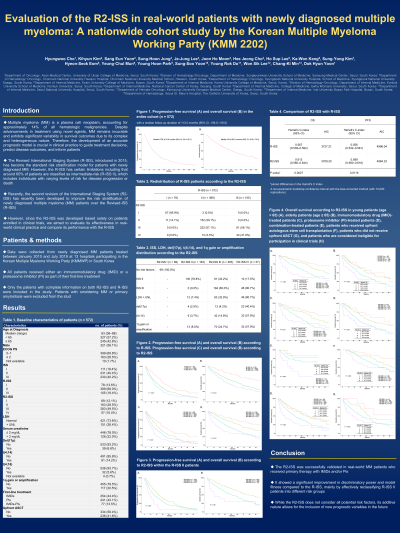Treatment of Newly Diagnosed Myeloma - Transplant Eligible
Poster Session 1
P-135: Evaluation of the R2-ISS in real-world patients with newly diagnosed multiple myeloma: A nationwide cohort study by the Korean Multiple Myeloma Working Party (KMM 2202)
Wednesday, September 27, 2023
1:30 PM - 2:30 PM EEST

.jpg)
Hyungwoo Cho
Professor
Asan Medical Center, University of Ulsan College of Medicine, Republic of Korea
Introduction: The second revision of the International Staging System (R2-ISS) has recently been developed to improve the risk stratification of newly diagnosed multiple myeloma (NDMM) patients over the Revised-ISS (R-ISS). We aimed to evaluate its effectiveness in real-world clinical practice and compare its performance with the R-ISS
Methods: We collected clinical and laboratory data from newly diagnosed MM patients treated between January 2010 and July 2019 at 13 hospitals participating in the Korean Multiple Myeloma Working Party (KMMWP) in South Korea. A total of 572 newly diagnosed MM patients who received IMiDs and/or PIs as part of their first-line treatment and had complete information on R2-ISS and R-ISS were included in the study.
Results: The median age was 63 years (range: 36–88), with 245 patients (42.8%) being 65 years or older. According to the R2-ISS, 69 (12.0%), 163 (28.5%), 283 (49.5%), and 57 (10.0%) patients were classified as stages I, II, III, and IV, respectively. We observed a significant difference in median overall survival (OS) among the four stages of R2-ISS (111.7, 82.8, 49.1, and 26.1 months for stages I, II, III, and IV, respectively; P < 0.001). In addition, significant differences in OS were observed among the R2-ISS stages within the R-ISS II patients (n = 389). Median OS was not reached in R2-ISS I (n = 2), 82.8 months (95% CI: 67.3–125.9) in R2-ISS II (n = 152), 49.6 months (95% CI: 40.2–62.4) in R2-ISS III (n = 105), and 14.9 months (95% CI: 5.7–NA) in R2-ISS IV patients (n = 44) (P < 0.001). Notably, the R2-ISS demonstrated a significantly higher C-statistic for OS compared to the R-ISS (0.613 vs. 0.567; P = 0.003), along with a substantial difference in Akaike's information criterion between the two models (3709.2 vs. 3727.2). Furthermore, the R2-ISS successfully stratified patients with different survival outcomes based on age (elderly or young), treatment (PIs, IMiDs, or IMiDs plus PIs), eligibility for upfront autologous stem cell transplantation, and eligibility for clinical trial participation.
Conclusions: In conclusion, the R2-ISS was successfully validated in real-world MM patients who received primary therapy with IMiDs and/or PIs. It showed a significant improvement in discriminatory power and model fitness compared to the R-ISS, mainly by effectively reclassifying R-ISS II patients into different risk groups. While the R2-ISS does not consider all potential risk factors, its additive nature allows for the inclusion of new prognostic variables in the future.
Methods: We collected clinical and laboratory data from newly diagnosed MM patients treated between January 2010 and July 2019 at 13 hospitals participating in the Korean Multiple Myeloma Working Party (KMMWP) in South Korea. A total of 572 newly diagnosed MM patients who received IMiDs and/or PIs as part of their first-line treatment and had complete information on R2-ISS and R-ISS were included in the study.
Results: The median age was 63 years (range: 36–88), with 245 patients (42.8%) being 65 years or older. According to the R2-ISS, 69 (12.0%), 163 (28.5%), 283 (49.5%), and 57 (10.0%) patients were classified as stages I, II, III, and IV, respectively. We observed a significant difference in median overall survival (OS) among the four stages of R2-ISS (111.7, 82.8, 49.1, and 26.1 months for stages I, II, III, and IV, respectively; P < 0.001). In addition, significant differences in OS were observed among the R2-ISS stages within the R-ISS II patients (n = 389). Median OS was not reached in R2-ISS I (n = 2), 82.8 months (95% CI: 67.3–125.9) in R2-ISS II (n = 152), 49.6 months (95% CI: 40.2–62.4) in R2-ISS III (n = 105), and 14.9 months (95% CI: 5.7–NA) in R2-ISS IV patients (n = 44) (P < 0.001). Notably, the R2-ISS demonstrated a significantly higher C-statistic for OS compared to the R-ISS (0.613 vs. 0.567; P = 0.003), along with a substantial difference in Akaike's information criterion between the two models (3709.2 vs. 3727.2). Furthermore, the R2-ISS successfully stratified patients with different survival outcomes based on age (elderly or young), treatment (PIs, IMiDs, or IMiDs plus PIs), eligibility for upfront autologous stem cell transplantation, and eligibility for clinical trial participation.
Conclusions: In conclusion, the R2-ISS was successfully validated in real-world MM patients who received primary therapy with IMiDs and/or PIs. It showed a significant improvement in discriminatory power and model fitness compared to the R-ISS, mainly by effectively reclassifying R-ISS II patients into different risk groups. While the R2-ISS does not consider all potential risk factors, its additive nature allows for the inclusion of new prognostic variables in the future.
